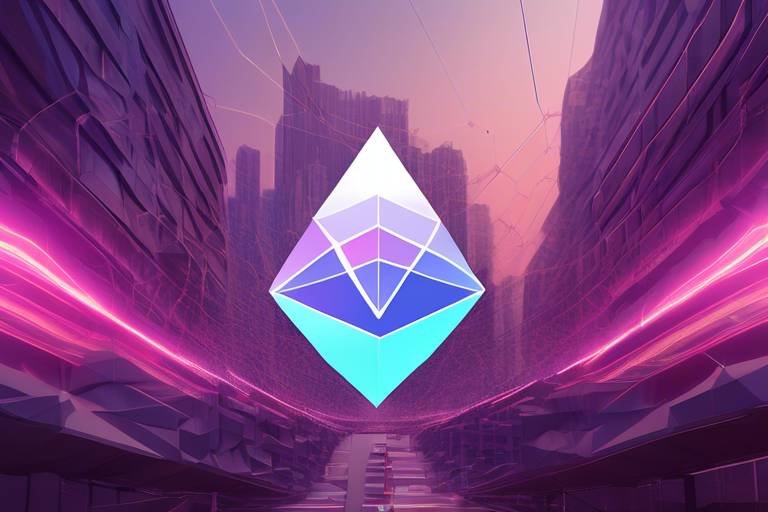Elrond - Speed and Scalability Combined
In the ever-evolving world of blockchain technology, where speed and scalability are paramount, Elrond emerges as a beacon of innovation. Imagine a bustling highway where vehicles zoom past without traffic jams, and you begin to grasp the essence of what Elrond offers. This platform is not just another player in the blockchain arena; it’s a revolution that enhances the way decentralized applications and smart contracts operate. With a unique architecture designed to optimize performance, Elrond is setting a new standard for what blockchain can achieve.
At its core, Elrond combines cutting-edge technologies like sharding and a secure proof-of-stake consensus mechanism. These elements work in harmony to ensure that transactions are processed at lightning speed while maintaining a high level of security. This article will take you on a journey through Elrond’s innovative architecture, shedding light on how it achieves unparalleled performance and scalability. By the end, you’ll understand why Elrond is not just a choice but a necessity for anyone looking to leverage the power of blockchain.
As we dive deeper into Elrond's architecture, we will unravel the intricacies of its sharding mechanism, explore the benefits it brings, and understand the role of its proof-of-stake model. Whether you are a developer, investor, or simply a tech enthusiast, the insights provided here will equip you with the knowledge to appreciate the transformative potential of Elrond in the digital landscape.
So, buckle up as we explore the fast lanes of Elrond, where speed meets scalability, and discover why this platform is poised to become a dominant force in the blockchain ecosystem.

Understanding Elrond's Architecture
Elrond's architecture is like a finely tuned machine, engineered to deliver exceptional performance in the ever-evolving blockchain space. At its core, Elrond integrates two groundbreaking technologies: sharding and secure proof-of-stake. These components work together to enhance the platform's speed and scalability, setting it apart from traditional blockchain solutions. Imagine a bustling highway; with Elrond's architecture, multiple lanes are open, allowing countless vehicles (transactions) to travel simultaneously without traffic jams (congestion).
Sharding is a revolutionary concept that breaks down the blockchain into smaller, manageable pieces called shards. Each shard operates independently, processing its own transactions and smart contracts. This parallel processing capability is akin to a multi-lane highway where each lane can handle its own traffic without interfering with the others. As a result, Elrond can achieve a staggering transaction throughput, capable of handling thousands of transactions per second, all while maintaining low latency.
On the other hand, the secure proof-of-stake (PoS) consensus mechanism is instrumental in ensuring the security and integrity of the network. Unlike traditional proof-of-work (PoW) systems that rely on energy-intensive mining processes, Elrond's PoS model incentivizes participants to validate transactions based on the number of tokens they hold and are willing to "stake." This not only enhances security but also promotes decentralization, as anyone with a stake can contribute to network validation.
To better understand how these components interact, let’s break down the architecture into its fundamental parts:
- Shards: Divided into state shards and transaction shards, each serving distinct functions.
- Secure Proof-of-Stake: A consensus mechanism that ensures security while rewarding validators.
- High Throughput: The ability to process a vast number of transactions quickly and efficiently.
The combination of these elements results in a robust and efficient blockchain ecosystem that can support a wide array of decentralized applications (dApps) and smart contracts. Elrond's architecture is not just about speed; it’s about creating a sustainable and scalable environment that can adapt to the needs of users and developers alike. With such a solid foundation, Elrond is poised to lead the charge in the blockchain revolution, offering a platform that is both powerful and user-friendly.

The Role of Sharding in Elrond
Sharding is often described as the secret sauce that makes Elrond not just another blockchain, but a powerhouse of speed and efficiency. Imagine a busy highway during rush hour; if every car (or transaction, in this case) had to travel on the same lane, traffic would come to a standstill. Now, picture that same highway with multiple lanes, each one capable of moving cars simultaneously. That’s essentially what sharding does for Elrond. By dividing the network into smaller segments, or shards, Elrond allows for parallel processing of transactions, significantly enhancing its scalability and overall performance.
Each shard operates independently, meaning that while one shard is busy processing a transaction, others can do the same without any interference. This is akin to having several checkout counters open at a grocery store: customers can check out faster when there are more counters available. In Elrond's case, this architecture enables the network to handle thousands of transactions per second, making it a formidable player in the blockchain ecosystem.
The brilliance of sharding lies not just in its ability to increase throughput but also in its efficiency. As the number of users and transactions grows, traditional blockchains often struggle with congestion, leading to slower transaction times and higher fees. Elrond, on the other hand, mitigates these issues through its innovative sharding mechanism. This ensures that users can enjoy a seamless experience without the typical bottlenecks seen in other platforms.
To understand the full impact of sharding in Elrond, it’s essential to look at the different types of shards being utilized:
- State Shards: These shards are responsible for storing the blockchain's state, which includes all the data necessary to maintain the network's integrity. They enable efficient data management, ensuring that information is readily accessible and organized.
- Transaction Shards: As the name suggests, these shards focus on processing transactions. They allow for simultaneous execution, meaning multiple transactions can be confirmed at once, drastically reducing waiting times.
By employing both state and transaction shards, Elrond has crafted a multi-faceted approach to scalability. The interaction between these shards is designed to optimize the overall performance of the network, ensuring that it remains responsive even as demand surges.
Ultimately, the role of sharding in Elrond cannot be overstated. It not only enhances the platform's speed but also positions it as a viable solution for decentralized applications and smart contracts. As we continue to explore the potential of blockchain technology, sharding will undoubtedly play a pivotal role in shaping the future of how we transact and interact online.
Here are some common questions regarding Elrond's sharding mechanism:
- What is sharding? Sharding is a method of partitioning a database into smaller, more manageable pieces, allowing for parallel processing of transactions.
- How does Elrond’s sharding improve scalability? By dividing the network into independent shards, Elrond can process multiple transactions simultaneously, significantly increasing throughput.
- Are there any downsides to sharding? While sharding improves performance, it can introduce complexity in terms of data consistency and network management.

Types of Shards
Elrond's innovative approach to blockchain technology is significantly enhanced by its sharding mechanism, which divides the network into smaller, manageable segments known as shards. This division is not just a random cut; it is a strategic move to optimize the overall performance of the network. Each shard operates independently, allowing for parallel processing of transactions, which is crucial for maintaining high speeds and scalability. Within Elrond's architecture, there are primarily two types of shards: state shards and transaction shards. Understanding these two categories is essential for grasping how Elrond achieves its remarkable efficiency.
State shards are responsible for storing the current state of the blockchain. Think of them as the library of the network, where all the information is cataloged and managed efficiently. These shards ensure that the data is organized and accessible, enabling quick retrieval and updates. The ability to manage vast amounts of data while maintaining high performance is what sets Elrond apart from traditional blockchains. By distributing the state across multiple shards, Elrond minimizes congestion and improves data management, which is crucial for any decentralized application (dApp) that relies on real-time data.
On the other hand, transaction shards focus on processing transactions. Imagine a busy highway with multiple lanes; each lane represents a transaction shard that can handle a separate transaction simultaneously. This parallel execution capability is vital for achieving high throughput, allowing Elrond to process thousands of transactions per second without breaking a sweat. The efficiency of transaction shards ensures that users experience low confirmation times, making the platform not only fast but also reliable.
In summary, the combination of state shards and transaction shards creates a robust ecosystem within Elrond. Each type of shard plays a unique role, contributing to the overall performance and scalability of the network. This design allows Elrond to stand out in the crowded blockchain landscape, making it a go-to platform for developers and businesses looking to harness the power of decentralized technology.
- What is sharding in blockchain? Sharding is a method of partitioning data in a blockchain network into smaller, more manageable pieces known as shards, allowing for parallel processing and increased scalability.
- How does Elrond's sharding work? Elrond uses state shards to store the blockchain's state and transaction shards to process transactions, enabling high throughput and low latency.
- What are the benefits of using state and transaction shards? State shards improve data management while transaction shards enhance transaction speed, together contributing to Elrond's overall efficiency and scalability.

State Shards Explained
In the world of blockchain technology, state shards play a pivotal role in enhancing the overall performance and scalability of networks like Elrond. But what exactly are state shards, and why are they so important? To put it simply, state shards are segments of the blockchain that maintain the state of the network, including account balances, smart contract data, and other essential information. By dividing this data into smaller, manageable pieces, Elrond can process information more efficiently, akin to how a librarian organizes books into different sections for easier access.
Imagine a library where every book is crammed into a single shelf. Finding a specific book would be a nightmare, right? Now, picture that same library with multiple shelves, each dedicated to a specific genre. This is the essence of state shards in Elrond. By categorizing data, the network can quickly retrieve and update information without getting bogged down by the sheer volume of transactions.
One of the most significant advantages of state shards is their ability to facilitate efficient data management. Since each shard operates independently, the network can handle numerous transactions simultaneously. This parallel processing capability allows Elrond to achieve an impressive transaction throughput, which is crucial for applications that require rapid responses, such as decentralized finance (DeFi) platforms and gaming applications.
To further illustrate the concept, let’s consider a simple analogy. Think of state shards as different departments in a restaurant. Each department—be it the kitchen, the bar, or the dining area—has its own responsibilities. When a customer places an order, the kitchen prepares the food, the bar serves drinks, and the waitstaff delivers everything to the table. By working independently yet cohesively, the restaurant can serve customers quickly and efficiently. Similarly, state shards enable Elrond to manage its data effectively, ensuring that all parts of the network function smoothly.
In terms of technical specifications, state shards are designed to store specific data structures that represent the blockchain's state. This includes not only user balances but also the current status of smart contracts and other essential elements that define the network's operation. By optimizing how this data is stored and accessed, Elrond significantly reduces the time it takes to process transactions, thereby enhancing the user experience.
In summary, state shards are a fundamental component of Elrond's architecture, enabling the network to achieve high levels of performance and scalability. By breaking down the blockchain's state into smaller, more manageable pieces, Elrond ensures that it can handle the demands of a growing user base and an increasing number of decentralized applications. As the digital landscape continues to evolve, the importance of such innovations cannot be overstated, positioning Elrond as a leader in the blockchain space.
| Feature | Benefit |
|---|---|
| Efficient Data Management | Faster transaction processing |
| Parallel Processing | Increased throughput |
| Independent Operations | Reduced congestion |
- What are state shards? State shards are segments of the blockchain that store the network's state, allowing for efficient data management and faster transaction processing.
- How do state shards improve performance? They enable parallel processing of transactions, which enhances throughput and reduces latency.
- Why are state shards important for decentralized applications? They allow applications to operate smoothly by ensuring quick access to necessary data, thus improving user experience.

Transaction Shards Explained
Transaction shards are a vital component of Elrond's innovative architecture, playing a crucial role in enhancing the network's overall performance. By dividing the workload into smaller, manageable segments, transaction shards allow for the simultaneous processing of multiple transactions. Imagine a busy restaurant where each chef specializes in a different dish; this division of labor enables the kitchen to serve customers much faster than if one chef were responsible for the entire menu. Similarly, transaction shards streamline the processing of transactions, leading to increased efficiency and reduced wait times.
In a traditional blockchain setup, every transaction must be processed sequentially, which can lead to bottlenecks, especially during peak times. However, with Elrond's transaction shards, the network can handle a vast number of transactions at once, significantly boosting its throughput. This capability is essential for applications that require rapid transaction confirmations, such as decentralized finance (DeFi) platforms and gaming applications where speed is crucial.
Each transaction shard operates independently, meaning that they can validate and process transactions without waiting for other shards to catch up. This parallel processing not only enhances speed but also contributes to the network's resilience. If one shard experiences high traffic or faces an issue, the others can continue to operate smoothly, ensuring that the entire network remains functional and responsive.
Moreover, transaction shards are designed to work in tandem with state shards. While transaction shards focus on processing transactions, state shards handle the storage and management of the blockchain's state. This symbiotic relationship between the two types of shards ensures that the Elrond network remains both fast and secure. The seamless interaction between transaction and state shards allows for quick updates to the blockchain, making it easier to maintain a consistent and accurate state across the network.
To illustrate how transaction shards function within the Elrond ecosystem, consider the following table that outlines their key features:
| Feature | Description |
|---|---|
| Parallel Processing | Allows multiple transactions to be processed simultaneously, increasing throughput. |
| Independence | Each shard operates independently, reducing bottlenecks and improving efficiency. |
| Integration with State Shards | Works alongside state shards to ensure data consistency and quick updates. |
| Scalability | Can handle thousands of transactions per second, making it suitable for high-demand applications. |
In summary, transaction shards are a game-changer for Elrond, providing the speed and scalability necessary for modern blockchain applications. By enabling parallel processing and working in harmony with state shards, they ensure that the network can handle high volumes of transactions without compromising performance. As the demand for fast and efficient blockchain solutions continues to grow, Elrond's innovative use of transaction shards positions it as a frontrunner in the evolving digital landscape.
- What are transaction shards? Transaction shards are segments of the Elrond network that process transactions simultaneously, enhancing speed and efficiency.
- How do transaction shards improve performance? They allow for parallel processing of transactions, reducing bottlenecks and enabling the network to handle thousands of transactions per second.
- What is the relationship between transaction shards and state shards? Transaction shards focus on processing transactions, while state shards manage the blockchain's state, working together to maintain overall network performance.
- Why is scalability important in blockchain? Scalability ensures that a blockchain can handle increasing amounts of transactions without slowing down, which is crucial for applications like DeFi and gaming.

Benefits of Elrond's Sharding Mechanism
Elrond's sharding mechanism is not just a technical marvel; it's a game changer in the blockchain realm. By effectively dividing the network into smaller, manageable pieces, or shards, Elrond significantly enhances its overall performance. Imagine a bustling highway where traffic is divided into multiple lanes; this is how sharding operates within Elrond's architecture. Each shard can process transactions independently, which leads to a multitude of benefits that position Elrond as a formidable player in the blockchain ecosystem.
One of the most notable advantages of Elrond's sharding is the reduction of congestion. Traditional blockchains often face bottlenecks as they process transactions sequentially. In contrast, Elrond's sharding allows for parallel transaction processing, which means that thousands of transactions can occur simultaneously without overwhelming the network. This capability is akin to having multiple cashiers at a grocery store instead of just one; customers are checked out much faster, leading to a smoother experience.
Furthermore, this mechanism leads to faster transaction speeds. With the ability to handle thousands of transactions per second, Elrond ensures that users experience minimal delays. Imagine waiting in line for a roller coaster; the longer the wait, the less fun it is. Elrond eliminates that wait time, making it an attractive platform for developers and users alike.
Additionally, Elrond's sharding enhances network efficiency. Each shard can focus on specific types of transactions or data, optimizing resource use and improving overall performance. For instance, while one shard is busy processing smart contracts, another can handle simple transfers. This specialization not only boosts speed but also ensures that the network remains agile and responsive to varying demands.
Moreover, the sharding mechanism contributes to lower operational costs. With reduced congestion and faster processing times, the costs associated with transactions and network usage can decrease significantly. This is particularly beneficial for decentralized applications (dApps) that require frequent interactions, as it allows developers to offer competitive pricing to their users.
In summary, the benefits of Elrond's sharding mechanism are multifaceted and transformative. They include:
- Reduced Congestion: Parallel processing minimizes bottlenecks.
- Faster Transaction Speeds: Thousands of transactions processed simultaneously.
- Enhanced Network Efficiency: Specialization of shards for optimized performance.
- Lower Operational Costs: More efficient transactions lead to reduced fees.
Elrond's innovative approach to sharding not only addresses the common challenges faced by traditional blockchains but also sets a new standard for what can be achieved in terms of speed and scalability. As the digital landscape continues to evolve, Elrond stands out as a platform that is not just keeping up but leading the way.
1. What is sharding in blockchain?
Sharding is a method of partitioning a blockchain network into smaller segments (shards), allowing for parallel processing of transactions. This enhances scalability and reduces congestion.
2. How does Elrond's sharding improve transaction speeds?
By allowing multiple shards to process transactions simultaneously, Elrond can handle thousands of transactions per second, significantly reducing confirmation times.
3. What are the benefits of using Elrond for decentralized applications?
Elrond offers high transaction speeds, lower operational costs, and enhanced efficiency, making it an attractive choice for developers looking to build dApps.
4. How does Elrond's sharding compare to other blockchain solutions?
Unlike many traditional blockchains that process transactions sequentially, Elrond's sharding allows for parallel processing, leading to better scalability and performance.

Secure Proof-of-Stake Mechanism
Elrond's Secure Proof-of-Stake (PoS) mechanism is a game-changer in the world of blockchain technology. Unlike traditional systems that rely on energy-intensive mining, Elrond’s PoS is designed to be both efficient and secure. This innovative approach not only enhances the network's performance but also promotes decentralization, making it an attractive option for developers and users alike.
At the core of Elrond's PoS is the idea of validators. These are the participants who secure the network by validating transactions and creating new blocks. In return for their efforts, validators are rewarded with ELGD, the native token of the Elrond network. What’s fascinating is that the rewards are not just a one-time incentive; they are structured to encourage long-term participation. This creates a stable and secure environment, where validators are motivated to act in the network's best interest.
One of the standout features of Elrond's PoS is its adaptive mechanism. This means that the network can dynamically adjust the number of validators based on the current load and requirements. As the network grows, so does the number of validators, which in turn increases the network's security and efficiency. This flexibility is crucial in a rapidly evolving digital landscape, where scalability and speed are paramount.
| Feature | Elrond's PoS | Traditional PoW |
|---|---|---|
| Energy Consumption | Low | High |
| Transaction Speed | High | Variable |
| Decentralization | Enhanced | Limited |
| Rewards | Consistent and Adaptive | Block-based and Variable |
Moreover, Elrond’s PoS mechanism addresses some of the common criticisms associated with proof-of-stake systems. For instance, it mitigates the risk of centralization, where a few large holders could dominate the network. Instead, Elrond encourages a diverse range of validators, ensuring that no single entity can control the blockchain. This is achieved through the staking process, where participants can stake their tokens to become validators, thus democratizing access to the network.
In summary, Elrond's Secure Proof-of-Stake mechanism is not just a technical specification; it's a holistic approach that redefines how blockchain networks can operate. By prioritizing security, efficiency, and decentralization, Elrond sets itself apart as a leading contender in the blockchain space. As the digital landscape continues to evolve, the importance of such innovative mechanisms cannot be overstated. They are the backbone of a future where decentralized applications can thrive, making Elrond a platform to watch.
- What is the main advantage of Elrond's PoS over traditional PoW?
Elrond's PoS is more energy-efficient, faster, and promotes decentralization compared to the energy-intensive proof-of-work systems. - How are validators rewarded in Elrond?
Validators earn rewards in the form of ELGD tokens for their contributions to securing the network. - Can anyone become a validator on Elrond?
Yes, anyone can participate by staking their tokens, making it accessible for a larger group of individuals. - How does Elrond ensure network security?
The adaptive PoS mechanism increases the number of validators as needed, which enhances security and efficiency.

Comparing PoS to PoW
When we dive into the world of blockchain, two terms often come up: Proof of Stake (PoS) and Proof of Work (PoW). These are the consensus mechanisms that keep the blockchain running smoothly, but they operate in fundamentally different ways. Think of PoW as a giant puzzle competition where miners race to solve complex mathematical problems. The first one to crack the code gets to add a new block to the chain and is rewarded with cryptocurrency. While this sounds exciting, it requires massive amounts of computational power and energy, leading to concerns about environmental impact.
On the other hand, PoS flips the script. Instead of relying on computational power, it allows validators to create new blocks based on the number of coins they hold and are willing to "stake" as collateral. This means that the more you stake, the higher your chances of being chosen to validate transactions. This mechanism not only reduces energy consumption significantly but also enhances network security. Why? Because validators have a vested interest in maintaining the integrity of the blockchain; if they act maliciously, they risk losing their staked coins.
To better illustrate the differences, let’s take a look at the key features of both mechanisms in the table below:
| Feature | Proof of Work (PoW) | Proof of Stake (PoS) |
|---|---|---|
| Energy Consumption | High | Low |
| Security | Dependent on computational power | Dependent on staked assets |
| Transaction Speed | Slower due to mining time | Faster as validators are pre-selected |
| Centralization Risk | Higher due to mining pools | Lower as it encourages broader participation |
As you can see, PoS offers several advantages over PoW, especially in terms of energy efficiency and transaction speed. In a world where sustainability is becoming increasingly important, PoS is a more eco-friendly option that aligns well with the growing demand for greener technologies. Additionally, because PoS encourages participants to stake their coins, it fosters a sense of community and shared responsibility, which is essential for the long-term health of any blockchain network.
In summary, while PoW has been the backbone of early cryptocurrencies like Bitcoin, PoS is paving the way for a more sustainable and efficient future in blockchain technology. Elrond’s choice to implement PoS not only enhances its performance but also positions it as a forward-thinking platform ready to tackle the challenges of the digital age.

Incentives for Validators
In the bustling world of blockchain technology, validators are the unsung heroes who keep the network running smoothly. In the case of Elrond, these validators are not just participants; they are rewarded for their crucial role in maintaining the integrity and functionality of the network. So, what exactly are these incentives, and why do they matter?
First and foremost, validators in Elrond are compensated through transaction fees and block rewards. Every time a transaction is processed, a small fee is paid, which is then distributed among the validators. This creates a direct financial incentive for validators to ensure that transactions are validated quickly and accurately. Moreover, as the network grows and more transactions occur, the potential earnings for validators can increase significantly.
Additionally, Elrond employs a unique mechanism that allows validators to earn rewards based on their stake in the network. The more tokens a validator holds and commits to the network, the greater their potential rewards. This system not only encourages validators to invest in the network but also aligns their interests with the overall health and success of the Elrond ecosystem. Essentially, it's a win-win situation where validators are motivated to act in the best interest of the network.
Another compelling aspect of Elrond's incentive structure is the dynamic reward system. Unlike traditional models, where rewards are fixed, Elrond adjusts the rewards based on network activity and performance. This means that during peak times when the network is under heavy load, validators can earn higher rewards for their efforts. Conversely, during quieter periods, the rewards may decrease. This dynamic approach not only keeps validators engaged but also ensures that the network remains robust and responsive to varying demands.
Furthermore, the community-driven aspect of Elrond adds another layer of incentive. Validators are encouraged to participate in governance decisions, allowing them to have a say in the future direction of the network. This democratic approach fosters a sense of ownership among validators, making them more invested in the network's success. In essence, by giving validators a voice, Elrond creates a stronger, more cohesive community that is dedicated to the platform's growth.
To summarize, the incentives for validators in Elrond are multifaceted and designed to promote active participation and commitment. Here’s a quick overview:
| Incentive Type | Description |
|---|---|
| Transaction Fees | Validators earn a portion of fees from each transaction processed. |
| Block Rewards | Validators receive rewards for creating new blocks in the blockchain. |
| Staking Rewards | Higher stakes lead to greater rewards, incentivizing investment in the network. |
| Dynamic Rewards | Rewards adjust based on network activity, providing incentives during peak times. |
| Governance Participation | Validators can influence network decisions, fostering a sense of ownership. |
In conclusion, Elrond’s innovative incentive structure not only rewards validators but also ensures that the network remains secure and efficient. By aligning the interests of validators with the health of the network, Elrond is paving the way for a more decentralized and robust blockchain ecosystem.
- What is the role of validators in Elrond? Validators are responsible for processing transactions, securing the network, and maintaining its integrity.
- How do validators earn rewards? Validators earn rewards through transaction fees, block rewards, and staking rewards based on their investment in the network.
- What is the difference between dynamic rewards and fixed rewards? Dynamic rewards adjust based on network activity, while fixed rewards remain constant regardless of network conditions.
- Can anyone become a validator on Elrond? Yes, anyone can become a validator by staking a minimum amount of Elrond tokens and meeting the network's requirements.

Real-World Applications of Elrond
Elrond's impressive speed and scalability capabilities are not just theoretical; they are making waves in the real world. With the ability to process thousands of transactions per second, Elrond is carving out a niche in various sectors, from decentralized finance (DeFi) to gaming and beyond. This versatility is crucial as businesses and developers seek blockchain solutions that can keep pace with their growth and innovation needs. Imagine a bustling marketplace where every transaction is seamless, quick, and secure—that's the promise Elrond delivers.
One of the standout applications of Elrond is in the realm of decentralized finance (DeFi). Traditional finance systems often suffer from slow transaction speeds and high fees, especially during peak times. In contrast, Elrond's architecture allows DeFi platforms to offer users a smooth experience with minimal costs. For instance, platforms built on Elrond can facilitate instant loans, swaps, and yield farming, enabling users to maximize their financial opportunities without the usual headaches.
Moreover, Elrond is also making a significant impact in the gaming industry. With the rise of blockchain gaming, players are looking for platforms that can provide fast and secure transactions. Elrond's low latency and high throughput are essential for games that require real-time interactions, such as multiplayer online games and virtual worlds. Players can trade in-game assets or currencies without worrying about lag or bottlenecks, making the gaming experience much more enjoyable.
Additionally, Elrond's technology is being leveraged for supply chain management. In an era where transparency and traceability are paramount, businesses can use Elrond's blockchain to track products from origin to consumer. This not only ensures authenticity but also enhances trust among consumers. Imagine being able to scan a product and instantly see its entire journey—where it was sourced, how it was transported, and its current status—all thanks to the efficiency of Elrond.
To illustrate the diverse applications of Elrond, here’s a quick overview of key sectors benefiting from its technology:
| Sector | Application |
|---|---|
| Decentralized Finance (DeFi) | Instant loans, swaps, and yield farming |
| Gaming | Real-time interactions and in-game asset trading |
| Supply Chain Management | Product tracking and authenticity verification |
| Healthcare | Patient data management and secure records |
In healthcare, Elrond's blockchain can revolutionize how patient data is managed. By providing a secure and immutable ledger, healthcare providers can ensure that patient records are accurate and accessible only to authorized personnel. This not only enhances patient privacy but also streamlines processes, reducing the time spent on paperwork and improving overall care.
As we look toward the future, the potential applications of Elrond are boundless. With ongoing advancements in its technology and increasing adoption across various industries, Elrond is poised to become a cornerstone of the blockchain ecosystem. Whether it's enhancing financial services, revolutionizing gaming, or improving supply chain transparency, Elrond is truly a platform where speed and scalability meet real-world needs.
- What is Elrond? Elrond is a blockchain platform designed for high-speed transactions and scalability, making it ideal for decentralized applications.
- How does Elrond achieve high transaction speeds? Elrond combines sharding and a secure proof-of-stake mechanism to optimize performance and enable thousands of transactions per second.
- What are some use cases for Elrond? Elrond is used in various sectors including DeFi, gaming, supply chain management, and healthcare.
- Why is sharding important for Elrond? Sharding allows Elrond to process transactions in parallel, significantly enhancing scalability and efficiency.
Frequently Asked Questions
- What is Elrond?
Elrond is a blockchain platform designed for high speed and scalability, enabling decentralized applications and smart contracts to operate efficiently. Its innovative architecture combines sharding and secure proof-of-stake to enhance performance.
- How does sharding work in Elrond?
Sharding in Elrond divides the network into smaller segments, allowing for parallel processing of transactions. This means that multiple transactions can be processed at the same time, significantly increasing the throughput and efficiency of the network.
- What are state shards and transaction shards?
State shards are responsible for storing the blockchain's state and managing data efficiently, while transaction shards handle the processing of transactions. Together, they optimize Elrond's operations and enable it to maintain high transaction speeds.
- What are the benefits of Elrond's sharding mechanism?
The sharding mechanism in Elrond reduces congestion and enhances transaction speeds, allowing the network to handle thousands of transactions per second. This positions Elrond as a strong competitor in the blockchain ecosystem.
- What is the secure proof-of-stake mechanism?
Elrond's secure proof-of-stake (PoS) mechanism enhances security while ensuring high performance. It allows validators to participate in the network by staking their tokens, which helps maintain decentralization and incentivizes active participation.
- How does proof-of-stake compare to proof-of-work?
Proof-of-stake (PoS) is generally more energy-efficient than proof-of-work (PoW). While PoW requires extensive computational power for mining, PoS allows validators to earn rewards based on the number of tokens they hold and stake, making it a more sustainable option.
- What incentives are provided to validators in Elrond?
Validators in Elrond are incentivized through rewards for their contributions to the network's security and functionality. These incentives ensure that validators remain engaged and that the network operates smoothly.
- What are some real-world applications of Elrond?
Elrond's speed and scalability make it suitable for various applications, including decentralized finance (DeFi), gaming, and supply chain management. Its versatility demonstrates its potential to revolutionize multiple industries within the blockchain landscape.



















